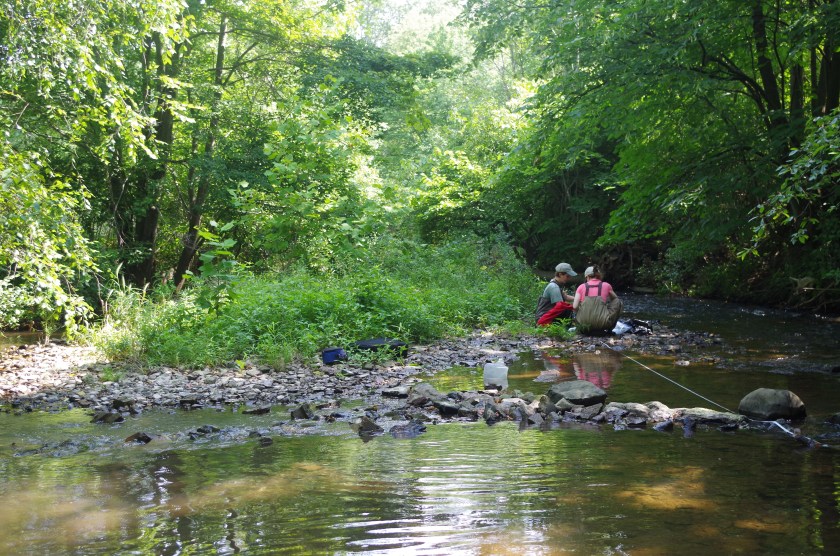Academy scientist Amanda Chan always knows the weather forecast. As field team leader for the Academy’s Patrick Center for Environmental Research, she is responsible for coordinating algae field crew members, logistics between groups of scientists, hiring, and, yes, the weather. The field crew ventures toward streams wearing thick rubber waders for long hours under the sun, a no-no in dangerously hot weather. For algae collection, the weather must also be dry — and it must have stayed that way for almost two weeks.
It simply didn’t in June and July 2019.

“Rain events raise the stream water levels and f low speed to a point where the algal communities are washed away. This is called a scouring event,” Chan says. “When this happens, we have to wait 10 days after a big rainstorm for algal communities to regrow in order for us to sample the stream. That waiting period hasn’t given us a big window to sample this season.”
Algae are a diverse group of aquatic organisms that use photosynthesis to grow and survive. They thrive either suspended in the water column or on rocks when sunlight, water temperature conditions and nutrients within the stream fuel their growth.

Algae are common in streams in the Delaware River watershed, which are often surrounded by agricultural fields, fertilized grass lawns or industrial sites. During a rainfall or flooding event, nutrients from nearby crop and plant fertilization, along with manure from livestock, flow into nearby streams, prompting increased algae growth.
That’s why Chan so carefully plans the timing of algae sampling.
As a key member of the coordinating committee of the Delaware River Watershed Initiative, a partnership of 50 environmental organizations funded by the William Penn Foundation, the Academy strives to monitor, protect and restore conditions in the streams, rivers and landscapes in targeted regions within the watershed. The scientists study communities of various aquatic organisms in streams to monitor water quality in suburban Philadelphia, North Jersey, South Jersey, counties of Montgomery, Berks, Chester, Carbon and Monroe and the Poconos. Alongside other factors, sampling algal communities enables our scientists to gauge how human influences are affecting natural systems.

Algae sampling needs to be done within the same time period each year for the Academy to make year-to-year comparisons and monitor any stream health changes, says Chan, and the Academy’s crew collects data every year between late June and mid-October. They try to collect all the samples before the leaves begin to fall from the trees in autumn, she says. If they wait, the rocks will be exposed to additional sunlight or will be covered by leaf fall that will promote or hinder algal biomass growth. In turn, their measurements will not reflect the algal communities’ true health within these streams.
With summer rains washing algae off the rocks and not enough time between storms for algae to regrow, this year’s field crew was literally running out of time to collect valuable data by early August. When they finally made it into the field in late summer, our scientists used a tool called a scumgetter to remove and “scrub” algae from rocks. Using the top of a toothbrush glued to the end of a syringe’s plunger, our scientists placed the syringe’s cylinder on a rock and twisted the brush around in circular motions, noting the amount of area scrubbed to collect a biomass measurement of the algae living on the rocks. With very little time to spare, they were able to collect the necessary samples for year-to-year comparison.

When rain prevents the field crew from measuring algae, Chan directs the team to conduct habitat surveys within the same areas where algae will later be collected. The team notes the characteristics of the riparian barrier, or the vegetation zone around the stream, including the presence or absence of invasive species, native trees, diversity in vegetation types and heights and any human influences on the riparian barriers. They also note in-stream habitat, including wood debris (such as logs or brambles), rock size (pebbles, sand or boulders) and aquatic plants that can provide habitat for fish and other aquatic organisms like insects. Taken together with data from these habitat surveys, as well as data on the fish and aquatic invertebrates in these areas, algae help provide holistic and ecological approach to understanding the health of a stream.
By Mary Alice Hartsock; Images by Patrick Center Staff/ANS
This text originally appeared in the fall/winter 2019 issue of Academy Frontiers, the Academy’s member magazine. Learn more about our summer 2019 fieldwork.

